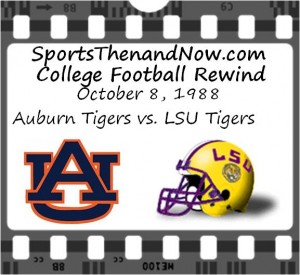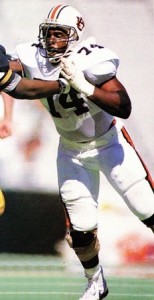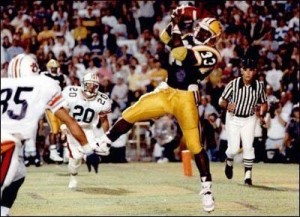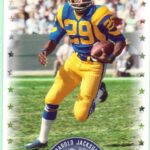College Football Classic Rewind: LSU Beats Auburn With Earth-shaking Touchdown
When it comes to the toughest stadiums to play in college football, the LSU Tigers’ Tiger Stadium in Baton Rouge, Louisiana is generally regarded as the toughest, especially on a Saturday night.
Over the years, “Death Valley” has been voted as the scariest place for a visiting road team to play a college football game because of the loud decibel levels that are provided by the partisan LSU faithful.
One night in October 1988, the LSU fans got so loud after the game-winning touchdown against Auburn, they produced an “earthquake” on the LSU campus.
LSU was playing host to #4 Auburn, who entered the game having won their first four games of the season by a combined score of 161 to 44.
The Tigers were led by head coach Pat Dye, who was in his eighth season at Auburn and complied a 61-21-2 record in his first seven seasons.
Even though he had enormously successful at Auburn as he won two SEC championships and had defeated arch rival Alabama four times during his tenure, the 1988 team was perhaps Dye’s best team as it featured a defense that allowed only 79 points through the 11 games of the regular season and had the best defensive player in the country in defensive lineman Tracy Rocker.
While Auburn came into the game on a roll, LSU came in limping as they had dropped their last two games and entered the game with a measly 2-2 record.
The Bayou Bengals were under the direction of second-year head coach Mike Archer who directed LSU to their first 10-win season in 25 years the previous season.
LSU was having a difficult time replacing all-American wide receiver Wendell Davis and 1,000 yard rusher Harvey Williams as they evident by their 19-6 loss to Florida the week before the Auburn game.
Junior quarterback Tommy Hodson and the LSU offense had their work cut out for them as they faced with the nation’s best defense on a Saturday night in “Death Valley”.
In the first quarter, Auburn drove into LSU territory three times but each time could not get into or were taken out of field goal range and were forced to punt the ball all three times.
Meanwhile, LSU mounted very little offense as they were unable to cross midfield at all during the first quarter.
Looking for a spark on offense, Archer took out Hodson and replaced him with backup Mickey Guidry on LSU’s first possession of the second quarter.
But Guidry was unable to move the Tigers either as LSU did not mount a drive in the first half as they punted on all seven of their possessions.
Late in the second quarter, Auburn moved into LSU territory again thanks to a pair of first-down runs by Vincent Harris and a LSU personal foul that had Auburn at the LSU 28-yard-line.
While the LSU defense did not permit another first down from that point, Auburn was able to get some points from this drive as Win Lyle drilled a 41-yard field goal to give Auburn a 3-0 lead, which was still the score as first half came to a close.
After another LSU punt on their opening possession of the second half, Auburn once again drove into LSU territory as Slack directed his Tigers down to the LSU 24-yard-line, only to have the drive end in a turnover as cornerback Mike Mayes deflected a Slack pass and was picked off by safety Greg Jackson.
Taking over from their own 18-yard-line, the LSU offense put together their best drive of the game as Hodson completed three passes for 49 yards and a defensive holding penalty on Auburn had the Tigers at the Auburn 23-yard-line.
However, the drive stalled as a 15-yard clipping penalty pushed LSU back to the Auburn 40-yard-line and forced a punt as the Bayou Bengals were out of field goal range.
Both teams exchanged punts until Auburn was able to drive to the LSU 20-yard line, thanks to three key completions by Slack for a total of 59 yards, early in the fourth quarter.
Once again, the LSU defense bended but did not break as they held to Auburn to another field goal as Lyle drilled a 33-yarder to increase Auburn’s lead to 6-0 with 10:12 left in the game.
After the field goal, Guidry came on for the second time in the game, but once again could not mount any offense and LSU was forced to punt again.
At this point of the game, the LSU offense had gained only 138 yards of total offense, made nine 1st downs, and crossed the 50-yard-line only once.
Despite their struggles on offense, LSU was still only behind 6-0 when they got the ball back at their own 25-yard-line, with Hodson back in the game, and 6:01 left on the clock.
The drive did not get off to a smooth start as Alvin Lee dropped a pass on the very first play.
However on the next play, Hodson found Tony Moss for a 17-yard gain and a first down.
The next play was another dropped pass, this time by tight end Willie Williams, who bounced back from the drop with a 12-yard catch and a 1st down at the Auburn 46-yard-line, the second time LSU had driven into Auburn territory.
The next two plays gained only five yards and LSU was faced with a 3rd-and-5 from the Auburn 41-yard-line.
That is when Hodson found Moss again, this time for 20 yards and a 1st down at the Auburn 21, the deepest LSU had driven in the game.
Then on the very next play, Hodson fired a bullet to running back Eddie Fuller, who was wide open at the one-yard-line, only to have Fuller drop what would have been the game-tying touchdown.
Fuller’s drop seemed to take the wind out of LSU’s sails as another incomplete pass and a one-yard scramble by Hodson led to a 4th-and-9 with 2:45 to go.
Hodson took the 4th down snap and found Williams at the 15-yard-line, who then turned it up field and broke through the tackles of Carlo Cheatham and Smokey Hodge to get the 1st down at the 11-yard-line.
With 1st-and-10, Hodson dropped back and found Fuller in the back of the end zone, who this time made the catch, but had his right foot out of bounds, negating the would-be touchdown.
Two straight incomplete passes led to a 4th-and-10 when Auburn called timeout to set up their defense with 1:47 left.
Though they could get a 1st down without scoring a touchdown, LSU knew that they had to get into the end zone or the game would be over.
With three receivers to the left side, Hodson dropped back and fired a pass, just a second before Auburn defensive tackle Ron Stallworth was about to sack him, for Fuller in the back of the end zone.
This time, Fuller made the catch and got was inbounds for a touchdown that sent the nearly 80,000 fans at Tiger Stadium into a frenzy that was so loud, that it registered on the seismograph at the LSU Geology Department in the Howe-Russell Geoscience Complex, just 1,000 feet away from the stadium.
Even though they had finally gotten into the end zone, LSU still needed to kick the extra point to take the lead.
And when David Browndyke easily sailed the kick through the uprights, LSU had a 7-6 lead with 1:41 to play in the game.
Alex Wright returned the ensuing kickoff to the Auburn 35-yard-line, giving the Tigers a chance to get into field goal range and come away with a victory.
But the Tigers could not gain a 1st down and when Slack overthrew Lawyer Tillman on 4th down, the LSU Tigers came away with a memorable 7-6 victory.
The loss for Auburn was the only one of the regular season as they finished 10-1 to win a share of the SEC title, but it prevented them for perhaps playing for a share of the national championship.
Instead, Auburn went to the Sugar Bowl, where they lost to Florida State 13-7 and finished #8 in the final AP poll and #7 in the final Coaches Poll.
Meanwhile, LSU would finish the regular season with an 8-3 record and were SEC co-champions with Auburn, but had to settle to play in the Hall of Fame Bowl in Tampa, where they lost to Syracuse 23-10 to finish the season with a #19 ranking in the AP Poll.
Since the SEC split into two divisions in 1992, LSU and Auburn have met every year in what has turned into one of the conference’s most intense rivalries as the winner of the game has gone to win the SEC Western Division and play in the SEC Championship Game seven times.
















